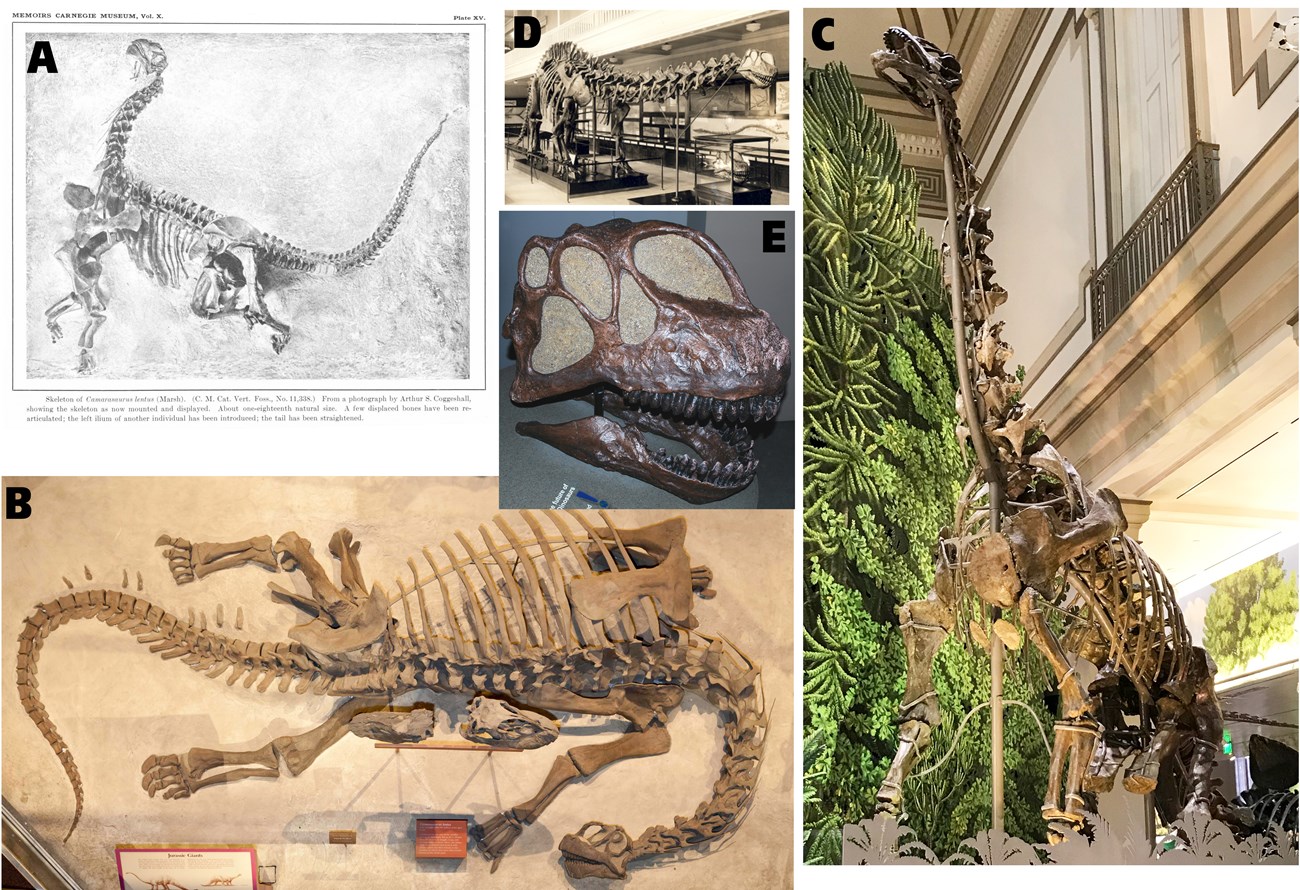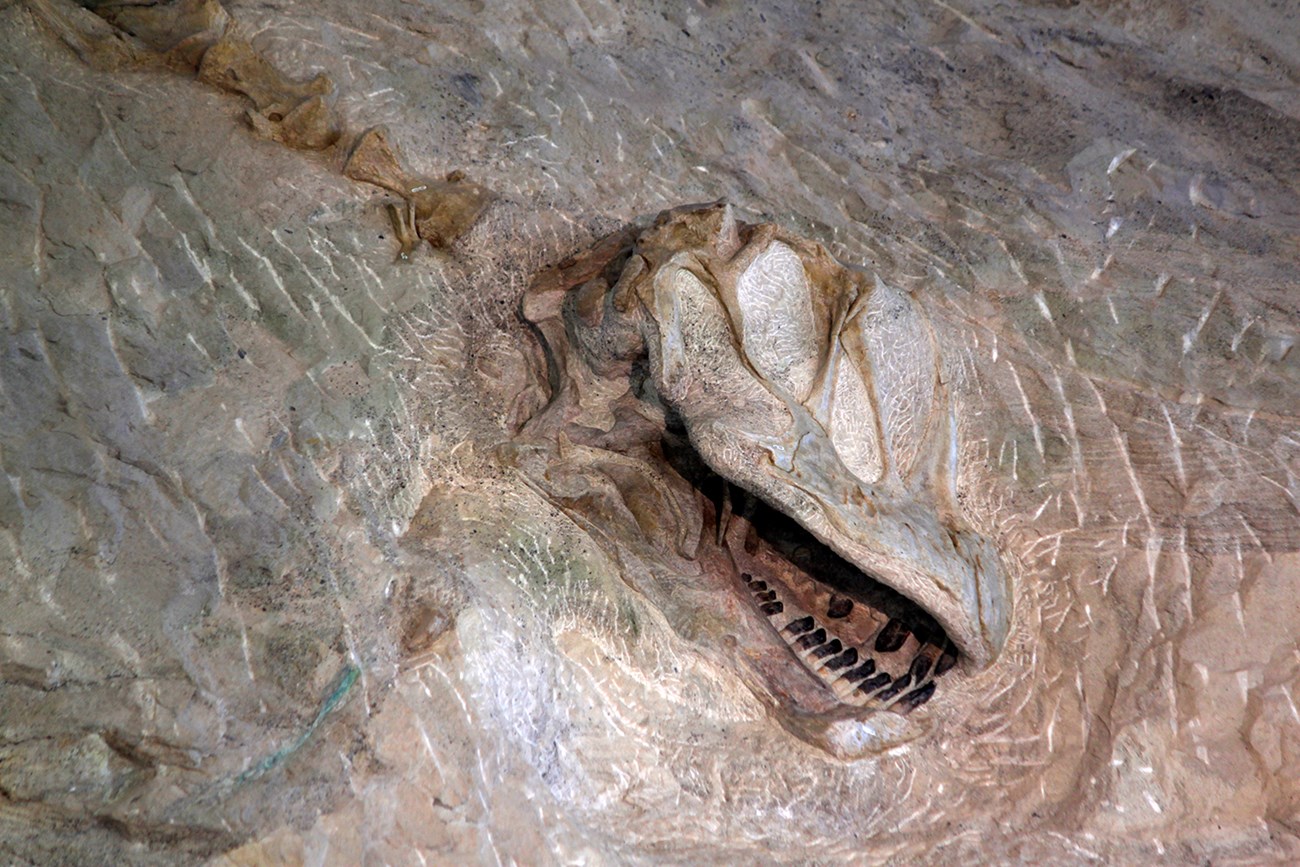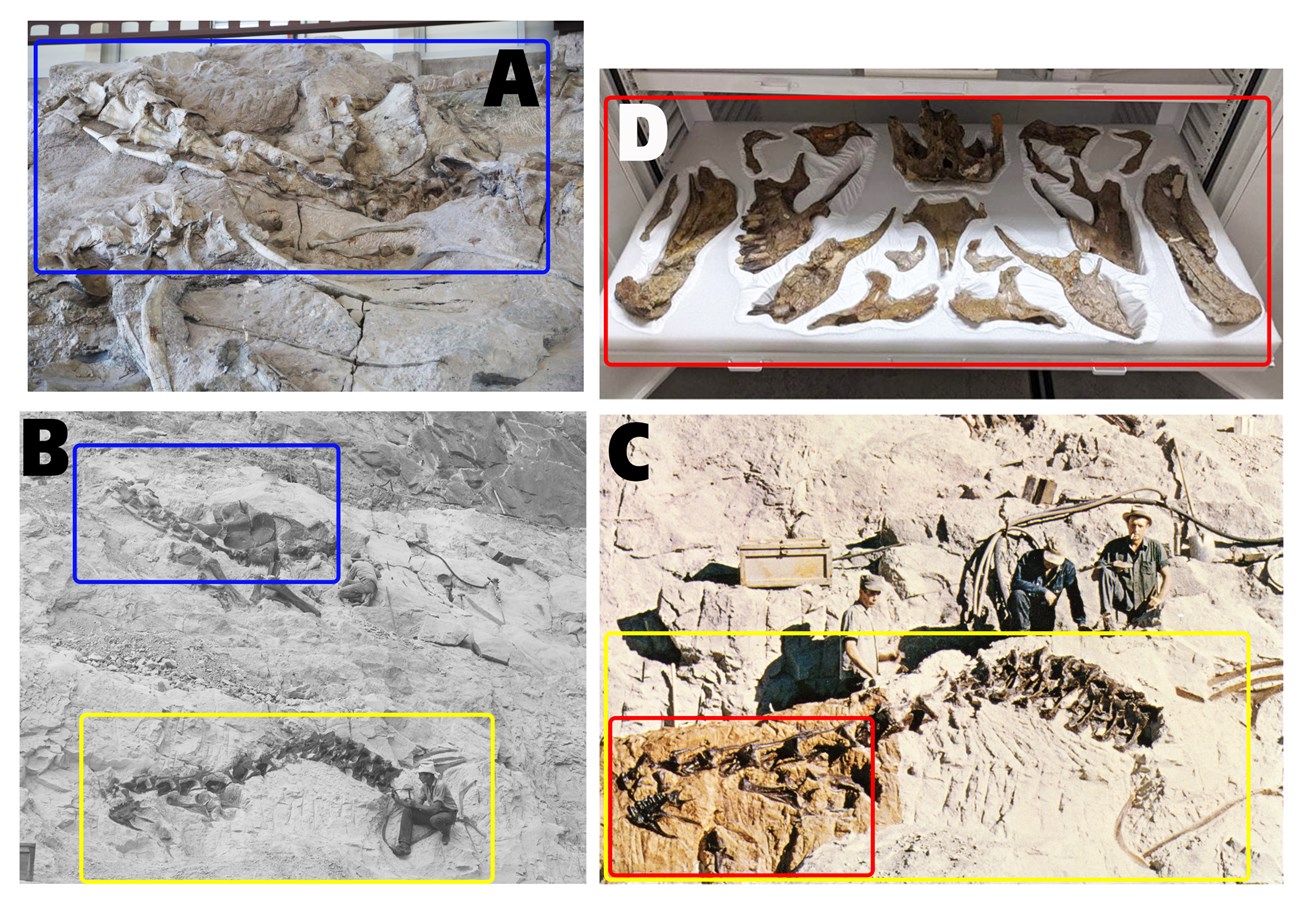Part of a series of articles titled Park Paleontology News - Vol. 13, No. 2, Fall 2021.
Article
Fantastic Camarasauruses (from Dinosaur National Monument) and Where to Find Them

ReBecca Hunt-Foster, Paleontologist
Dinosaur National Monument
Camarasaurus is a long-necked, well-known sauropod dinosaur found in the Late Jurassic-age rocks of the Morrison Formation (around 156–149 million years in age), which Dinosaur National Monument (DINO) is famous for. This large herbivorous dinosaur grew to 50 feet or more in length, and 15 high. Six skulls and three nearly complete skeletons of Camarasaurus have been discovered at the historic Carnegie Quarry in DINO, making it not only the most well represented animal in the Quarry itself, but also from the Morrison Formation across North America (McIntosh, 1981; Foster, 2020). The Carnegie Quarry was discovered just north of the town of Jensen, located in northeastern Utah, in 1909 by Earl Douglass, a paleontologist dispatched by the Andrew Carnegie to collect additional fossils of large dinosaurs for his new Carnegie Museum of Natural History.
Of these six skulls from DINO, the specimens excavated by the Carnegie Museum of Natural History (CM) at DINO include three notable specimens (Figure 1; McIntosh, 1981). The most well-known specimen of a juvenile dinosaur ever found happens to be a Camarasaurus (specimen CM 11338, Figure 1A), and still holds the title for the best preserved and most complete sauropod skeleton ever found (Gilmore, 1925). Collected between 1919 and 1920, it has been on exhibit at the Carnegie Museum of Natural History since 1924, and replicas can be seen in numerous museums, including the Quarry Exhibit Hall at DINO.

Figure 1: Specimens of Camarasaurus collected by the Carnegie Museum of Natural History – A) the juvenile Camarasaurus CM 11338 (Plate 15 from Gilmore 1925); B) USNM 13786, 15492 and 369928 in the historic death pose (photo by the National Museum of Natural History Department of Paleobiology) and the same specimens in C) in the newly renovated Deep Time exhibit (photo by author); D) CM 12020 on display at the Carnegie Museum of Natural History in 1932 upon the mount of the Apatosaurus skeleton (photo by the Carnegie Museum of Natural History) and E) on exhibit at the same museum in 2006 (photo by James St. John CC BY 2.0).
A second reasonably complete smaller subadult Camarasaurus (CM 11373), missing only the tail, was collected from 1918 to 1919, but was never prepared by the team at the Carnegie. This specimen was traded to the National Museum of Natural History (NMNH as USNM 13786) in Washington D.C. in 1935 (McIntosh, 1981). The specimen was prepared in front of the public in 1936 at the Texas Centennial Exposition in Dallas by Norman Boss and Gilbert Stucker, who realized that this specimen represented the second most complete specimen of a Camarasaurus (Lay, 2018; Telfer, 2015; Miller, 2012). A tail, also collected from the Quarry in 1912 (CM 3379), was transferred to the NMNH to complete this specimen (USNM 15492), though the tail is likely not from the same individual (McIntosh, 1981). The tail section was prepared by Norman Boss at the 1937 at the Greater Texas and Pan American Exhibition, from June to November, only to return to Washington where other needs and a lack of space delayed the final “preparation, restoration, mounting and related construction work” on the skeleton till 1946, when work resumed with help from preparators Franklin Pearce and Arlton Murray (Telfer, 2015; Telfer, pers. comm. 2021). The composite mount was installed at the NMNH in 1950 in a death pose (Figure 1B) and was put into a life pose for the new Deep Time exhibit which opened in 2019 (Figure 1C).
A disarticulated adult skeleton (CM 11393) with skull (CM 12020, Figure 1E) was collected from 1915 to 1916, and in 1932 a cast of this skull was used on the holotype of the Apatosaurus louisae mount, which was thought to have not had a skull associated with it and had been headless on exhibit since 1915 (Figure 1D). This Camarasaurus skull remained on the Apatosaurus mount for 47 years, until replaced with the correct Apatosaurus skull in October of 1979, after the work of Jack McIntosh and David Berman demonstrated that a separate skull found near the type specimen was the correct skull for the skeleton (Berman and McIntosh, 1978; McIntosh, 1981).
After the notable work by the Carnegie Museum from 1909 to 1922 (followed briefly by the National Museum of Natural History and University of Utah from 1923–1924), work at the Quarry was paused as plans for developing the then-new Dinosaur National Monument were explored. Work took place to remove the overburden covering the lower positions of the Carnegie Quarry from 1934 to 1938, with work suspended in 1938 due to the escalation of World War II (Carpenter, 2018; DINO Archives). This work resumed in September of 1953, removing up to 12 feet of bentonitic clay from the face of the quarry sandstone layer under the direction of Dr. Theodore “Ted” White, who had been hired as Dinosaur National Monument’s first “Museum Geologist” and Paleontologist (White, 1958).
During this time, three more significant Camarasaurus specimens were discovered, including the two Camarasaurus skulls that can still be seen on the Quarry wall today (Figure 2). The most iconic skull to spot on the Quarry wall is DINO 2580, which consists of a neck and skull, visible on the upper center portion of the Quarry wall and found on everything from pictures on postcards and in books, to mugs, stickers, and shirts. This specimen is complete except for the right lower jaw and a few bones of the roof of the mouth, which were removed to expose the underside of the skull for scientific study. The “hump” Camarasaurus is found on the upper western portion of the Quarry wall and is the most complete single specimen currently on the Quarry wall (Figure 3A and B). The skull (DINO 4393) is partially disarticulated and partially covered by other fossils, making it somewhat difficult to spot from the viewing platform. Both specimens were excavated on the Quarry wall during the 1950s.

NPS photo.
The final Camarasaurus skull known from the Carnegie Quarry comes from what was referred to as the “small Camarasaurus” – DNM 28 (now DINO 28). In June of 1955, quarry technicians, Frank McKnight and Floyd Wilkins, discovered the remains of what would become DNM 28 while removing overburden from the western portion quarry face, directly to the west of DINO 4393 (see Figure 3B and C). The modern-day quarry building had not yet been constructed (work began in May of 1957), and only part of the Quarry wall was covered under a temporary structure during this time. The specimen consists of the first six dorsal vertebrae with ribs, a complete cervical vertebral series, and a nearly complete skull, and represents the geologically youngest Camarasaurus skull known from the Quarry. The skull had naturally broken apart during the decay process and was not articulated, but closely associated (DINO Archives). The naturally separated skull bones were of significant scientific interest, with the braincase being the first well-preserved Camarasaurus braincase described in scientific literature (White, 1958). While there was discussion of mounting the specimen on the Quarry wall for visitors to view, due to the scientific significance of this specimen it was loaned to the NMNH in late 1956 where it remained for study until a portion came back in December of 1979, with the remainder returning in September of 1980. This skull was also cast by the NMNH where it is now on display in their Deep Time exhibit both on top of the mounted specimen, as well as a stand-alone exhibit (USNM 369928; Figure 1C; Carrano and Carpenter, pers. comm. 2021; DINO Archives). This specimen was the subject of conservation treatment by paleontology volunteer Virginia Robertson in August of 2021, and has been rehoused in a new, form-fitted archival cradle to support and hold the fossils in museum collections (Figure 3D).

Figure 3: A) The “hump” Camarasaurus, DINO 4393, as currently seen on the Carnegie Quarry Wall at Dinosaur National Monument; B) The blue box indicates the position of DINO 4393 as it was being excavated on the Quarry wall in 1955. The yellow box indicates the position of DINO 28 relative to DINO 4393; C) A close up view of DINO 28 as it is being excavated in 1955, with the red box indicating the are where the skull was found; D) DINO 28 today, as it is currently housed in the Dinosaur National Monument museum collections.
All photos by NPS.
Whether you are visiting the Quarry Exhibit Hall at Dinosaur National Monument to see the final resting place of these large camarasaurs or traveling to various museums around North America such as the Carnegie Museum of Natural History or the National Museum of Natural History, you now know where some of these fantastic animals were discovered and why they are so important.
References:
Berman, David S. and John S. McIntosh. 1978. Skull and relationships of the Upper Jurassic sauropod Apatosaurus (Reptilia, Saurischia). Bulletin of Carnegie Museum of Natural History 8: 1-35.
Carpenter, Kenneth. 2018. Rocky Start of Dinosaur National Monument (USA), the World’s First Dinosaur Geoconservation Site. Geoconservation Research 1(1): 1-20.
Foster, John R. 2020. Jurassic West. Indiana University Press.
Gilmore, Charles W. 1925. A nearly complete articulated skeleton of Camarasaurus, a saurischian dinosaur from the Dinosaur National Monument, Utah. Memoirs of the Carnegie Museum 10:347-384.
Lay, M. 2018. Norman H. Boss – A Near “Indispensible Man”. History of the NMNH Paleobiology Department. https://wayback.archive-it.org/org-660/20180716194432/https://paleobiology.si.edu/history/boss.html
McIntosh, John S. 1981. Annotated catalogue of the Dinosaurs (Reptilia, Archosauria) in the Collections of the Carnegie Museum of Natural History. Bulletin of Carnegie Museum of Natural History 18: 1-67.
Miller, Ben. 2012. Extinct Monsters: Diplodocus and Camarasaurus. Extinct Monsters. https://extinctmonsters.net/diplodocus-and-camarasaurus/
Telfer, A. 2015. When Camarasaurus Went to Texas. Digging the Fossil Record: Paleobiology at the Smithsonian. https://wayback.archive-it.org/org-660/20180208010003/http://nmnh.typepad.com/smithsonian_fossils/2015/01/camarasaurus-went-to-texas.html
White, Theodore E. 1958. The Braincase of Camarasaurus lentus (Marsh). Journal of Paleontology 32(3): 477-494
Related Links
- Dinosaur National Monument, Colorado and Utah—[Geodiversity Atlas] [Park Home]
- NPS—Fossils Through Geologic Time
- NPS—Fossils and Paleontology
- NPS—Geology
Last updated: October 7, 2021
